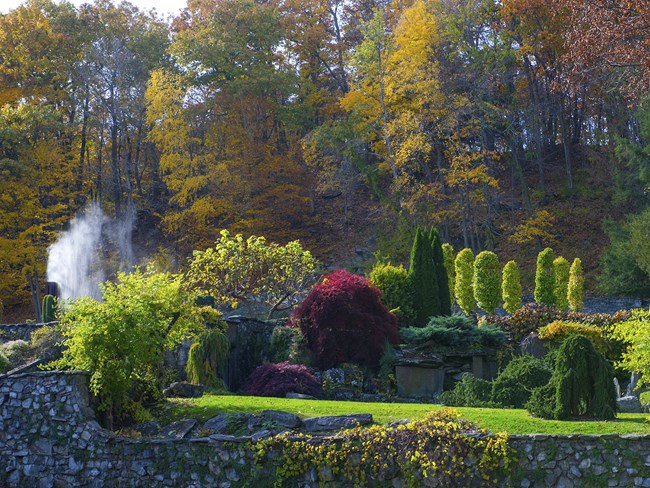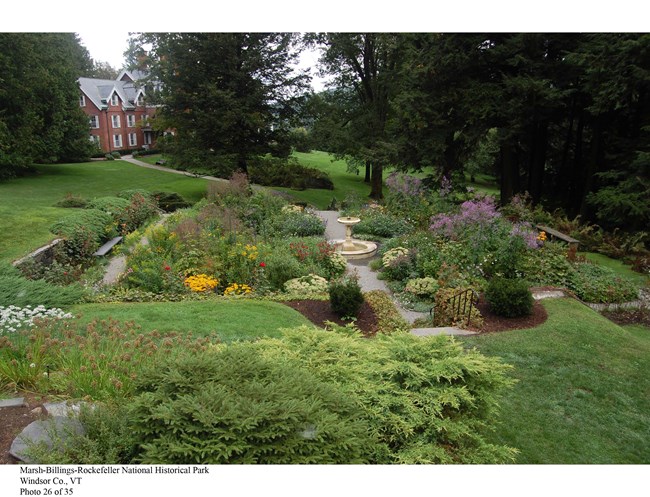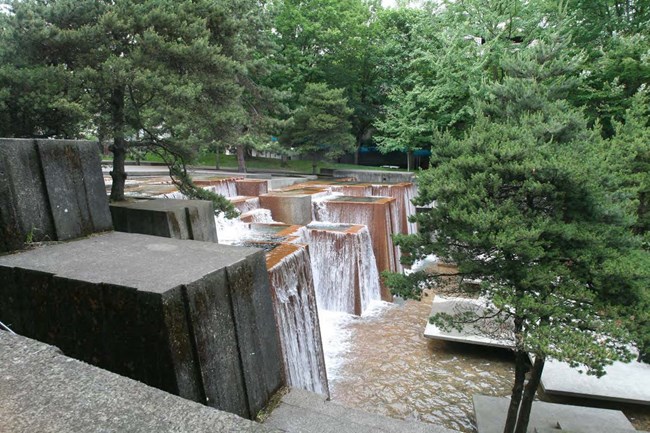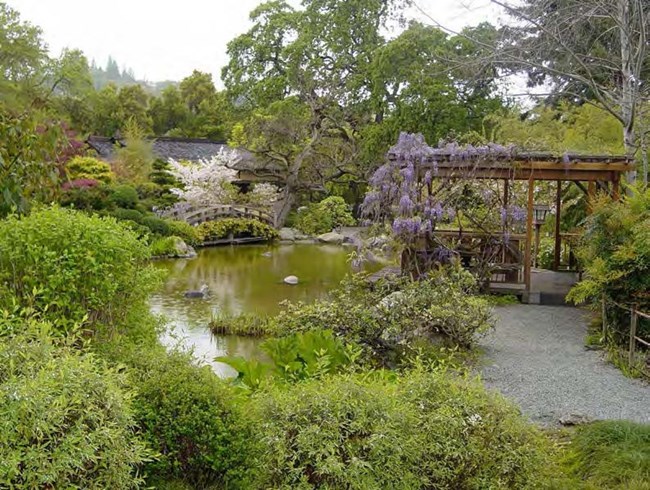The National Register of Historic Places is the official list of the Nation's historic places worthy of preservation. Authorized by the National Historic Preservation Act of 1966, the National Park Service's National Register of Historic Places is part of a national program to coordinate and support public and private efforts to identify, evaluate, and protect America's historic and archeological resources.
The National Register of Historic Places is pleased to promote awareness of and appreciation for historic places important in landscape architecture.
The National Register of Historic Places is pleased to promote awareness of and appreciation for historic places important in landscape architecture.
What is landscape architecture?
Landscape architecture is defined by the American Society of Landscape Architects (ASLA) as “…the profession which applies artistic and scientific principles to the research, planning, design and management of both natural and built environments. Practitioners of this profession apply creative and technical skills and scientific, cultural and political knowledge in the planned arrangement of natural and constructed elements on the land with a concern for the stewardship and conservation of natural, constructed and human resources. The resulting environments shall serve useful, aesthetic, safe and enjoyable purposes.” Beginning in the 19th century, landscape architecture came into its own. Frederick Law Olmsted, Sr., is often considered in the United States the Father of Landscape Architecture, with his design for Central Park in New York City in 1858. There were those before him, but Olmsted’s work, coming at a time when the industrial cities were growing and urban landscapes were thought beneficial to an expanding cosmopolitan population, really set the stage for those who would follow in his footsteps.

Photograph by Oliver Collins, courtesy of New York State Historic Preservation Office
Featured Historic Properties for Landscape Architecture Month:
Innisfree is a public garden of approximately 200 acres, blending Japanese, Chinese, Modern, and ecological design principles in Millbrook, a rural area roughly in the center of Dutchess County, New York. The public garden is the masterwork of Lester Collins, a seminal figure in American twentieth century landscape architecture. Innisfree’s distinctive sloping, rocky landscape, which forms the literal and visual foundation for the garden, is set within a natural bowl wrapping around the 40-acre Tyrrel Lake.Read more

Photograph by Katie Miller, PAL
Past Highlights:
Marsh-Billings-Rockefeller National Historical Park, Woodstock, Vermont
A model example of progressive private conservation practices during the late nineteenth and twentieth centuries. Marsh was born on the property and lived there through circa (c.) 1824; it remained his family home through 1869. His ground-breaking 1864 book, Man and Nature, laid the foundations for the conservation movement in America by elucidating a pragmatic approach to the stewardship of natural resources that suited the Industrial Age. It inspired Billings, who was born in nearby Royalton, Vermont, made his fortune as a real estate lawyer during the California Gold Rush, and later led the Northern-Pacific Railroad, to create a model country estate on the Marsh family property.
Flat Top Estate, Blowing Rock, North Carolina
At Flat Top, Moses Cone established a gentleman's country retreat in the style of those established by American captains of industry of the late nineteenth and early twentieth centuries. The historic district is nationally significant in the area of landscape architecture for the planning of the estate, in particular the extensive network of carriage roads and associated plantings designed by Moses Cone. The carriage roads are among very few such systems in private estates ofthis period in this country; represent extensive and careful design and planning; and remain nearly intact today.
Chandor Gardens, Weatherford, Texas
Chandor Gardens, a five-acre estate in Weatherford, Parker County, Texas, was the home and studio of English-born portrait painter Douglas Chandor and his wife Ina. The estate features a 1936 single-story eclectic residence and studio designed by Fort Worth architect Joseph Pelich, and lush Asian and English-inspired formal gardens designed and executed by Chandor up to the time of his

Photograph by Heritage Consulting Group, courtesy of Oregon State Historic Preservation Office
Halprin Open Space Sequence, Portland, Oregon
Constructed between 1966 and 1970 as a vital part of the South Auditorium Urban Renewal District, the Halprin Open Space Sequence is nationally significant under Criterion C for Landscape Architecture. Specifically, it is a masterwork by transformative landscape architect Lawrence Halprin. This work is one of the largest, most complex, comprehensive and sophisticated expressions of Halprin 's concepts for public plazas.Omaha Park and Boulevard System, Omaha, Nebraska
Omaha was one of the earliest Midwestern cities to develop and implement a complete park and boulevard plan. The System began in the late nineteenth century and was substantially complete by 1918.
Robert M. Hanes House, Winston-Salem, North Carolina
In 1937, Hanes commissioned New York landscape architect Ellen Shipman to design the rear garden for the residence. House and Garden magazine labeled her the “dean of American women architects.” Shipman designed a variety of garden types, but the best of her designs were characterized by domesticality, intimacy, romantic seclusion, and lush flowerbeds. The garden at the Robert M. Hanes House reflects Shipman’s design aesthetic by exhibiting many of the features she typically employed: an axial layout with a short vista, small lawns, a terrace, near symmetry, multiple levels, well-defined paths, walls, pools in a variety of shapes, a garden house, and a secluded seating area.
Mount Airy Forest, Cincinnati, Ohio
Conceived as the nation’s first urban reforestation project, the park has developed over the years—especially during the Depression and post-World War II period- into a park with a variety of areas, spaces and structures designed to accommodate recreational, social, and educational activities. Today it continues to offer a large expanse of protected land within the city limits where the public can enjoy the richness and diversity of nature.
Chiricahua National Monument Historic Designed Landscape, Cochise County, Arizona
Located within the Chiricahua National Monument, the Chiricahua National Monument Historic Designed Landscape consists of approximately 10,000 acres of stunning wilderness. Administered by the National Park Service, this scenic wilderness is 120 miles southeast of Tucson, Arizona, and located in the northwest portion of the Chiricahua Mountain range in southeastern Arizona. The Chiricahua National Monument is best known for the rock pinnacles for which the monument was created to protect. Rising sometimes hundreds of feet into the air, many of these pinnacles are balancing on a small base, seemingly ready to topple over at any time.
Cummer Gardens, Jacksonville, Florida
The Cummer Gardens, located on the grounds of the Cummer Museum of Art & Gardens on the western shore of the St. James River, in the historic Riverside neighborhood of Jacksonville, encompass 1.45 acres between the west bank of the river and the art museum. The gardens are unique in Florida and the southeast, representing the history of American landscape design in the first four decades of the 20th century. The gardens have direct ties to four leading American landscape designers and firms--Michigan based Ossian Simonds, Philadelphia’s Thomas Meehan & Sons, Ellen Biddle Shipman of New York, and the renowned Olmsted Brothers firm of Massachusetts.
Rock Creek Church Yard and Cemetery, Washington, DC
Rock Creek Church Yard and Cemetery contributes, significantly-to the cultural heritage and visual beauty of the District of Columbia. Covering 85 acres, the cemetery is sited on high ground, its undulating terrain falling away to the north from the main gate. The cemetery is the site of many memorials of distinguished aesthetic quality including not only the Adams Memorial (Grief) by sculptor Augustus Saint-Gaidens and architect Stanford White of McKim, Mead and White but also the Frederick Keep Monument (Journey of Life) by James Earle Fraser.

Photograph courtesy of California State Historic Preservation Office
The period of significance for the property is 1917-1941, during which the three main gardens and all contributing buildings and structures were built. Hakone was designed and built by talented Japanese designers and craftsmen, and during the late 1930s and early 1940s, a second generation of Japanese talent modified and added to the gardens. Hakone is unique in California and is a significant designed landscape that contains multiple contributing buildings and structures that embody high artistic values.
Jacques Marchais Center of Tibetan Art, Staten Island, New York
The Jacques Marchais Center of Tibetan Art, located in Staten Island, New York, at 338/336 Lighthouse Avenue, was listed in the National Register of Historic Places on May 29, 2009 for its association with Jacques Marchais (1887-1948), a pioneer collector and respected expert on Tibetan art. Marchais was an extraordinary American woman who created an institution to serve as a bridge between the west and the rich artistic and cultural traditions of Tibet and the Himalayan region.
Fort Worth Botanic Garden, Fort Worth, Texas
The Fort Worth Botanic Garden, located southwest of downtown Fort Worth, Texas, encompasses 109 acres of slightly rolling terrain originally marked by native stands of deciduous trees (trees that lose their leaves seasonally). Listed in the National Register of Historic Places for national significance in the area of Landscape Architecture, the Fort Worth Botanic Garden is an excellent example of a designed landscape and as one of the first multiple rose gardens established in the southern half of the United States.
North Inlet Trail, Rocky Mountain National Park, Larimer County, Colorado
Rocky Mountain National Park offers many scenic trails for the enrichment of the visitor. The North Inlet Trail, located on the west side of the Rocky Mountain National Park, offers visitors a grand view of lakes, forest and mountains while offering campsites along the way.
Lake Haiyaha Trail, Rocky Mountain National Park, Larimer County, Colorado
Rocky Mountain National Park offers many scenic trails for the enrichment of the visitor. The North Inlet Trail, located on the west side of the Rocky Mountain National Park, offers visitors a grand view of lakes, forest and mountains while offering campsites along the way.
Skyline Drive, Virginia
Skyline Drive is the only public road that travels the length of the National Park Service's Shenandoah National Park in the Blue Ridge Mountains of Virginia, measuring 105 miles of roadway. The drive runs the entire length of the northern and southern crests of the Blue Ridge Mountains. Built by the Civilian Conservation Corps (CCC) as part of President Franklin Delano Roosevelt’s New Deal Program, Skyline Drive is a testament to the expanding movement for conservation, public outdoor recreation, and regional planning that gained momentum in the 1920s and became the hallmark of Federal policy in the 1930s.
Will Rogers Park Gardens and Arboretum, Oklahoma City, Oklahoma
Named after Oklahoma' famous native son, Will Rogers, the Will Rogers Park Gardens and Arboretum are significant for landscape design and as a part of Oklahoma City's park system plan. The park was originally planned in 1909, then constructed in the 1930s by the CCC and WPA.
Riverview Park, Hannibal, Missouri
Riverview Park is a 465 acre park along the Mississippi River in the city of Hannibal. The park opened in 1909 thanks to the philanthropy of Wilson Pettibone who wished to preserve the naturalness of the land, and avoid traces of artificiality. Riverview Park is a mature arboretum and is a good example of of the prairie style of landscape design.
Lincoln Park Lily Pool, Chicago , Illinois
This 3-acre Lily Pool is an exquisite hidden garden in Chicago 's Lincoln Park that symbolically celebrates the natural and pre-history of the Midwest .
Manitoga (Russel Wright Home & Studio), Garrison, New York
A founding member of the American Society of Industrial Designers, Wright was well-known as the designer of the “American Modern” style in domestic decorative arts (furniture, fabrics, glassware, and tableware) and as the inventor of the still popular sectional sofa.
Learn More:
National Register of Historic Places on Flickr: Landscape Architecture properties: The National Register is on Flickr, this subset of photographs are of landscape architecture properties.National Park Service Landscape Architecture Website
Last updated: April 13, 2022
